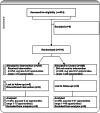The impact of real-time alerting on appropriate prescribing in kidney disease: a cluster randomized controlled trial
- PMID: 26615182
- PMCID: PMC11740753
- DOI: 10.1093/jamia/ocv159
The impact of real-time alerting on appropriate prescribing in kidney disease: a cluster randomized controlled trial
Abstract
Background: Patients with kidney disease are at risk for adverse events due to improper medication prescribing. Few randomized controlled trials of clinical decision support (CDS) utilizing dynamic assessment of patients' kidney function to improve prescribing for patients with kidney disease have been published.
Methods: We developed a CDS tool for 20 medications within a commercial electronic health record. Our system detected scenarios in which drug discontinuation or dosage adjustment was recommended for adult patients with impaired renal function in the ambulatory and acute settings - both at the time of the initial prescription ("prospective" alerts) and by monitoring changes in renal function for patients already receiving one of the study medications ("look-back" alerts). We performed a prospective, cluster randomized controlled trial of physicians receiving clinical decision support for renal dosage adjustments versus those performing their usual workflow. The primary endpoint was the proportion of study prescriptions that were appropriately adjusted for patients' kidney function at the time that patients' conditions warranted a change according to the alert logic. We employed multivariable logistic regression modeling to adjust for glomerular filtration rate, gender, age, hospitalized status, length of stay, type of alert, time from start of study, and clustering within the prescribing physician on the primary endpoint.
Results: A total of 4068 triggering conditions occurred in 1278 unique patients; 1579 of these triggering conditions generated alerts seen by physicians in the intervention arm and 2489 of these triggering conditions were captured but suppressed, so as not to generate alerts for physicians in the control arm. Prescribing orders were appropriate adjusted in 17% of the time vs 5.7% of the time in the intervention and control arms, respectively (odds ratio: 1.89, 95% confidence interval, 1.45-2.47, P < .0001). Prospective alerts had a greater impact than look-back alerts (55.6% vs 10.3%, in the intervention arm).
Conclusions: The rate of appropriate drug prescribing in kidney impairment is low and remains a patient safety concern. Our results suggest that CDS improves drug prescribing, particularly when providing guidance on new prescriptions.
Keywords: AKI; CKD; appropriate prescribing; clinical decision support; medication dosing; renal insufficiency.
© The Author 2015. Published by Oxford University Press on behalf of the American Medical Informatics Association. All rights reserved. For Permissions, please email: journals.permissions@oup.com.
Conflict of interest statement
None.
Figures




References
-
- Uchino S, Kellum JA, Bellomo R, et al. . Acute renal failure in critically ill patients: a multinational, multicenter study. JAMA. 2005;294(7):813–818. - PubMed
-
- Mehta RL, Pascual MT, Soroko S, et al. . Spectrum of acute renal failure in the intensive care unit: the PICARD experience. Kidney Int. 2004;66(4):1613–1621. - PubMed
-
- Yong TY, Fok JS, Ng PZ, et al. . The significance of reduced kidney function among hospitalized acute general medical patients. QJM. 2013;106(1):59–65. - PubMed
Publication types
MeSH terms
LinkOut - more resources
Full Text Sources
Other Literature Sources

